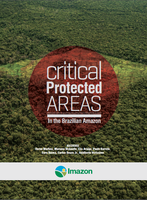 Martins, H., Vedoveto, M., Araújo, E., Barreto, P., Baima, S., Souza Jr., C., & Veríssimo, A. 2012. Critical Proteced Areas in the Brazilian Amazon (p. 98). Belém: Imazon. Find the PAs in the Brazilian Amazon in most critical situation with regard to deforestation and initiatives to reduce their size or protection status. Protected Areas (PAs)1 have proven to be effective against the advance of deforestation in the Brazilian Amazon (Arima et al. 2007; Soares-Filho et al. 2010).
Martins, H., Vedoveto, M., Araújo, E., Barreto, P., Baima, S., Souza Jr., C., & Veríssimo, A. 2012. Critical Proteced Areas in the Brazilian Amazon (p. 98). Belém: Imazon. Find the PAs in the Brazilian Amazon in most critical situation with regard to deforestation and initiatives to reduce their size or protection status. Protected Areas (PAs)1 have proven to be effective against the advance of deforestation in the Brazilian Amazon (Arima et al. 2007; Soares-Filho et al. 2010).
From 2004 to 2006, for example, deforestation in the region fell by 37% as the result of the creation of approximately 485 thousand square kilometers of Conservation Units (UC) from 2003 to 2006 (Soares-Filho et al. 2010). This amount represents 40% of the UCs existing in the Legal Amazon in 2010 (Imazon & ISA, 2011).
However, deforestation and forest degradation have threatened the integrity of some of those areas. Until July, 2011, deforestation in PAs already corresponded to 7% of the total deforestation occurring in the Legal Amazon. Furthermore, there has been increasing pressure to downgrade, downsize and degazette protected areas from both agribusiness segments and local residents and the government itself. For example, Ara.jo and Barreto (2010) have identified 48 PAs under this kind of threat in the Brazilian Amazon. Among actual and potential Protected Area Downgrading, Downsizing and Degazettement (PADDD) cases, the authors found that 29 PAs had lost 49 thousand square kilometers and another 18 were still at risk of losing 86 thousand square kilometers.
Additionally, in June 2012, the National Congress approved Federal Law no. 12,678 which increased the boundaries of the Campos Amazônicos National Park (PARNA), but excluded areas of this park and downsized another 7 UCs by a total of 1,644.8 square kilometers without any public consultation and socioenvironmental impact studies (Piovesan & Siqueira, 2012). The objective of the changes was to regularize occupied areas and allow implementation of the Jirau, Santo Antônio and Tabajara hydroelectric dams in Rondônia, and the Tapajós hydroelectric complex in Pará. Initiatives such as these create precedents and expectations that other UCs may also be downsized in the same way (Araújo et al. 2012). The situation may become even more serious, considering that the government intends to invest 96 billion reais in order to generate 42,000 MW of hydroelectricity by 2020 in the Amazon, as indicated by the Growth Acceleration Program (Programa de Aceleração do Crescimento – PAC) (MME, 2011).
In this report we present the PAs in the Legal Amazon that have the most critical situation with regard to deforestation and PADDD threats. For deforestation we analyzed: the absolute loss of original forest from 2009 to 2011; the percentage loss of original forest from 2009 to 2011; and the percentage of remaining forest in 2011. With regard to PADDD threats, we analyzed the PAs that could undergo changes due to proposed legislation, legislative decrees, lawsuits or planned hydroelectric dams. The objective of this report is to reveal the priority areas for interventions that will ensure the objectives of conservation and protection of the rights of indigenous and traditional populations.
Download the file here
